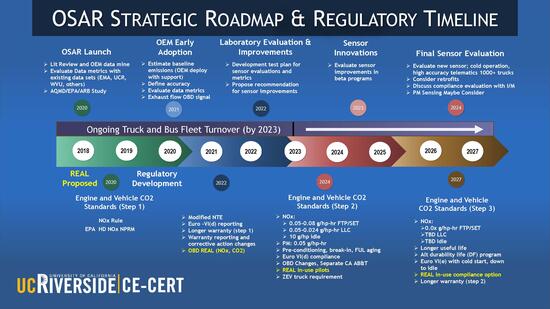OSAR Consortium
Directory

About OSAR
The Onboard Sensing, Analysis and Reporting (OSAR) Consortium is a CE-CERT-led initiative uniting academia, government, and industry partners to advance the next generation of real-world vehicle emissions monitoring. Under the direction of Dr. Kent Johnson, the consortium is developing reliable, continuous onboard emissions measurement systems that can transform how mobile source emissions are regulated and enforced.
Through collaborative research, OSAR is working to reduce environmental impacts in overburdened regions—such as California’s Inland Empire—by shifting the focus from lab-based certification to in-use emissions verification supported by real-time data.

Mission
The OSAR Consortium’s mission is to create a paradigm shift in how vehicle emissions are regulated. By leveraging advancements in onboard sensors, data science, and connected vehicle technologies, OSAR aims to move beyond lab-based certification models toward continuous, real-world emissions measurement. Current regulatory standards are based on simulated driving cycles that may not accurately represent in-use conditions. OSAR’s vision is to measure all vehicles, all the time, providing a data-driven basis for compliance and certification that reflects actual on-road emissions.
Initial research focuses on creating onboard reporting systems for the heavy-duty truck sector, with long-term goals to include light-duty and non-road mobile sources. Funding from consortium members will help demonstrate scalable, real-world systems and guide the development of in-use regulatory approaches.
Members
OSAR's founding members include leaders in environmental policy and mobile source regulation:
-
U.S. Environmental Protection Agency (EPA)
-
California Air Resources Board (CARB)
-
South Coast Air Quality Management District (SCAQMD)
-
Engine Manufacturers Association (EMA)
-
Manufacturers of Emission Controls Association (MECA)
Membership is open to public, private, and academic institutions aligned with OSAR’s mission to advance real-world emissions compliance through innovative, practical, and equitable solutions.
Interested in joining? Contact Kent Johnson at kjohnson@cert.ucr.edu.
Objectives
-
Next Generation Sensor Development
- Investigate technical development needs such as operating temperature range, cross-sensitivities between NOx and ammonia, performance at a wide range of loads, and overall durability
- Overcome technical limitations that will make it possible to install sensors aboard every vehicle and revolutionize regulatory strategy and compliance costs.
-
Data Analysis Modeling
Rigorously examine needed elements of the data analysis and modeling structure including:
- Emission factor reporting algorithms (note that current emission factor algorithms only consider pass-fail criteria of the vehicle under real world conditions)
- Modeling pollutants for emission species where measurements do not exist
- Integrate sensors and reported data analysis into the onboard sensing system and develop a real-time analysis and reporting system using vehicle connectivity acceptable to both the manufacturer, the user, and the regulatory agencies.
-
System Verification
- Provide reliability, accuracy, and efficacy if new systems architecture by conducting pilot studies and showcasing results
- Provide recommendations for standardization of real-time reporting
- Provide recommendations for possible regulatory opportunities for adjusting compliance and certification options using OSAR technology
